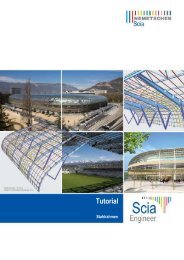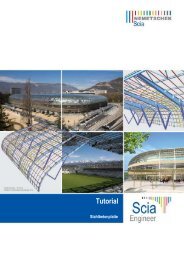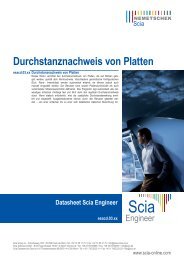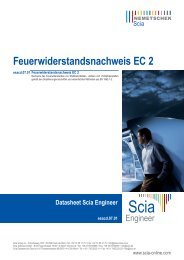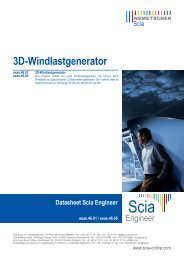Advanced Package Training Scaffolding 2011.1 - Scia-Software GbR
Advanced Package Training Scaffolding 2011.1 - Scia-Software GbR
Advanced Package Training Scaffolding 2011.1 - Scia-Software GbR
You also want an ePaper? Increase the reach of your titles
YUMPU automatically turns print PDFs into web optimized ePapers that Google loves.
86<br />
<strong>Advanced</strong> <strong>Training</strong><br />
In our example the structure was unclad. We will take a look at the force parallel to the façade, so cf =<br />
1,3.<br />
The site coefficient cs :<br />
Cladding condition of the<br />
system configuration<br />
Site coefficient<br />
Normal to the façade Parallel to the façade<br />
Unclad 0,75 1,0<br />
Clad 1,0 1,0<br />
NOTE: The values for the site coefficients correspond to a façade with a solidity ratio ϕB= 0,4; see also EN12811-1.<br />
For an unclad structure, the wind parallel to the façade, results in cs = 1,0.<br />
For each beam the force can be calculated as a line force as shown below:<br />
<br />
= ∙ ∙ ∙ <br />
<br />
= 1,0 ∙ 0,0483 ∙ 1,3 ∙ 870 <br />
= 54,6 = 0,055<br />
<br />
This load is applied on the beams shown below (the toeboards are not taken into account, because the<br />
force coefficient is only available for tube profiles):<br />
So the total force inserted is:<br />
0,055 kN/m x<br />
[(2+2x0,5)x 2,57m<br />
+ (2x0,5)x 2m +3,257]<br />
= 0,055 kN/m (12,97m)<br />
= 0,71 kN<br />
In the calculation of “6. Load cases”, a load of 0,17kN/m² has been taken into account. This value<br />
multiplied with the surface (= 2m x 2,57m) gives a total force of 0,68kN.<br />
So the two option results in a value close to each other.



